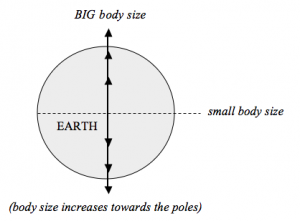 Is Bergmann’s rule valid?
Is Bergmann’s rule valid?
Biologist Carl Bergmann stated in the 19th century that as one goes further toward the poles of the earth, encountering colder and colder climates, animal body size generally gets bigger. For example, polar bears are bigger than brown bears. This rule mainly concerns endotherms and describes a tendency of body mass more than a absolute pattern.
Scientist Valerius Geist claims that Bergmann’s Rule is invalid. He points out that, contrary to Bergmann’s Rule, the smallest body sizes are found at the lowest and highest latitudes. If the rule were valid, this would not be the case; body size at these latitudes would be big. Instead of correlating body size to temperature, Geist links it to food availability.
Is Bergmann’s rule applicable to the Soay Sheep case?
Multiple Shrinking Sheep actors address the theory proposed by Bergmann, which would be an easy tool to explain why Soay sheep are getting smaller as temperature is getting warmer. Shane Maloney supports this theory.
But Tim Coulson points out that no one is sure how quickly animals would adapt to different latitudes or temperatures. As temperature changes, animals either migrate or adapt. In general, the scientists acknowledge Bergmann’s Rule, but in the case of the Shrinking Sheep, the phenomenon seems to be too quick to be explained by Bergmann’s rule: no one knows how quickly a species would adapt to conform to the rule.
